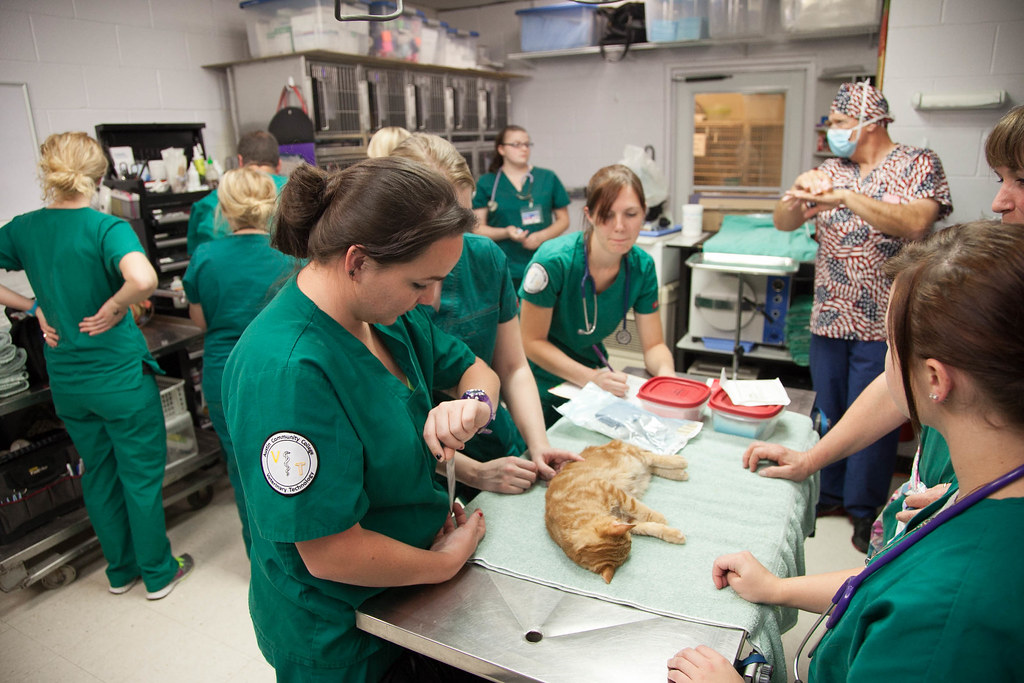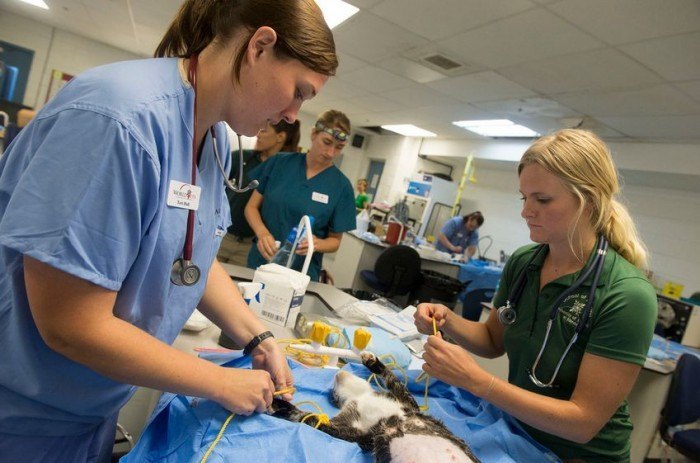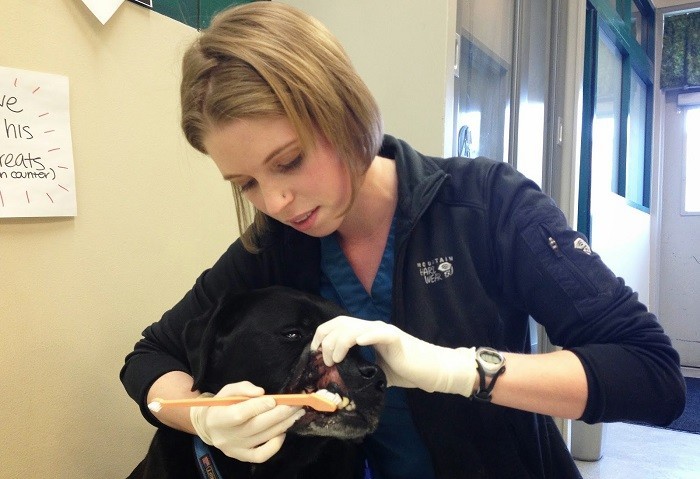Like many professions, the average vet tech salary depends on many factors. The field of veterinary technology has a wide salary range depending on the region, your specific job experience, where you’re choosing to work, and how long you’ve been working in the field.
With such an array of income potential, as a prospective student or fresh graduate, you might wonder what you’re going to be making after investing in an education. A love of animals can’t pay the bills, after all, so it’s important to enter a career with animals that can let you live a financially stable life.
** Find a school near you and request your info packet to start your vet tech career today!
Here is a table of with the average salary across the nation for all the different jobs working with animals.
| Occupation Field | Jobs | Hourly Avg. Pay | Annual Avg. Salary |
|---|---|---|---|
| Animal Scientists | 2350 | $34.90 | $72,590.00 |
| Zoologists & Wildlife Biologists | 18970 | $30.40 | $63,230.00 |
| Veterinarians | 62470 | $47.23 | $98,230.00 |
| Veterinary Technologists & Technicians | 93300 | $15.56 | $32,350.00 |
| Veterinary Assistants & Laboratory Animal Caretakers | 71060 | $12.20 | $25,370.00 |
| Animal Control Workers | 13450 | $16.52 | $34,370.00 |
| Animal Care & Service Workers | 172990 | $11.34 | $23,580.00 |
| Animal Trainers | 11170 | $15.58 | $32,400.00 |
| Nonfarm Animal Caretakers | 161820 | $11.04 | $22,970.00 |
| Animal Breeders | 1110 | $20.90 | $43,470.00 |
| Farmworkers Farm Ranch & Aquacultural Animals | 31540 | $12.10 | $25,160.00 |
*This table was populated May 2018 but was published by the BLS on May 2016.
Becoming a vet tech can have a wealth of benefits, providing you with a good salary and plenty of job satisfaction. If you enjoy working with pets, you will learn how to provide assistance to animals who have become unwell or are injured, and meet plenty of new people in this rewarding line of work.
 Students at Austin Community College Vet Tech Program.
Students at Austin Community College Vet Tech Program.
You will be assisting the veterinarian in his or her duties – usually in a veterinary surgery. Other job duties include administrating medication, and giving shots to animals in distress.
This highly specialized job position requires several years of training and experience before you can start working in an operational capacity. Learn how to use the relevant equipment that is vital to this role – such as x-ray machines – is also important.
Below are some tips on how to become a veterinary technician if you would like to work in this field, as well as the things you can do to improve your chances of securing this lucrative job.
Contents
How Long Is A Vet Tech Education
You will usually need to attend at least two years at a community college with a vet program before you can pass the examinations you need to secure a job as a vet tech. This will usually depend on the type of vet tech that you want to be, and you could be required to have completed as much as four years of college before you can qualify. The type of course you study and training you undergo will be dependent on how far you want to progress in this profession.
So how long does it take to become a vet tech?

Instructor demonstration pet CPR.
Here are some things to remember:
- Associate and bachelor degrees are both offered at various colleges across the country, and you may want to combine your studies with real-life experience as part of an internship or working scheme.
- An internship with a local veterinary practice in your area can also look great on your resume, so plan ahead early and apply to as many surgeries as you can. Write a covering letter with a few details about yourself, for example where you are studying and the course you are undertaken. You may also want to write about any qualities you feel that you could give to the role.
- Remember, not all internships are paid, although you may have your travel costs reimbursed to you at the end of the scheme. However, you will gain on-the-job-experience that could set you apart from other candidates when you decide to apply for a position in the future. For more information about internships in this profession, speak to a careers adviser at your college.
They could also tell you of other ways on how to become a vet tech, so just ask!
Becoming a Veterinary Technician
Gaining The Relevant Qualifications
After completing your education in the school of your choice, you will have to pass the relevant qualifications in order to become a vet tech. The Veterinary Technician National Exam, is a four-hour examination that will test you on the skills you have learned on your course. This could include animal nursing, surgical preparation, surgical procedures and pharmacology, as well as other topics.
Complete this exam if you wish to work at an animal hospital anywhere in the country, or a smaller clinic in your local area. Once you have passed your exams, you could find work in a hospital to get more real-world knowledge. Choose a position that will enable you to practice the skills you learned on your course, as well as a position that will give you the most realistic prospects of career progression.
National Association of Veterinary Technicians in America
The National Association of Veterinary Technicians in America, or NAVTA, is an organization that offers individuals the chance to progress their career and continue with their educational credit.
- Once you become a member of the organization, there will be plenty of opportunities to network with other industry leaders, as well as meeting some new friends who are looking for a similar job as you.
- Once you have spoken to more people who have progressed in this industry, you should think about specializing in one particular area of veterinary medicine. This could benefit you if you find a particular area of the industry more interesting or rewarding, or if the pay is better.
- Some of the fields you could specialize in include internal medicine, equine medicine, animal dentistry, critical care, or anesthesia. You may want to look into several of these fields before deciding that you want to specialize in one particular area.
How to be a vet tech is a loaded question as that is truly up to you. Once you become one then you will need to decide by which standards you hold yourself accountable as each individual will carry this profession differently than the other.
Vet Tech Salary Factors

Working in an animal hospital ER can boost your income.
Where you work will have the biggest impact on how much you’ll end up making and the main factor the will determine the salary of a vet tech.
If you’ve been researching this as a career, you’re well aware of the fact that you aren’t relegated to working in a traditional veterinary clinic; you can expand your horizons and work in a large variety of settings.
There are large, multi-doctor specialty clinics that focus on things like:
- Cardiology
- Dermatology
- And Internal Medicine
There are laboratories that will eagerly hire veterinary technicians to run tests, examine samples sent in from clinics across the country, and even develop new testing protocols. Humane societies like to have a trained vet tech on staff to help with spays and neuters, treat sick/abused animals, and perform health exams on animals that are being put up for adoption. The government even employs vet techs for jobs with health departments examining zoonotic (transmittable from animals to humans) diseases.
Make Above Average Salaries

Working in a shelter can be very rewarding.
On average, you’ll make the most money being employed by teaching hospitals at universities, top vet tech schools and colleges. If you have a lot of experience and advanced certifications, you can expect to make over $20 an hour with great benefits. You’ll also make a fair amount of money being employed by larger clinics, particularly hospitals that are certified by the American Animal Hospital Association (AAHA).
These clinics have a much higher standard of routine care, surgery, drug handling, and client services than non-certified hospitals, so they tend to hire more highly trained staff to adhere to these strict regulations. Depending on the region, technicians working in AAHA certified clinics can expect to start at $14-15 an hour with a full benefits package.
Smaller day practice technicians will have their vet tech salary based on experience and/or education. New technicians with a degree might make as much as a more experienced technician without a degree, but that depends on the clinic itself. New technicians, even with a degree, start out between $11-13 an hour, but that could be more in areas with a higher cost of living, like California or the east coast. The salary at a humane society or animal shelter depends on that shelter’s funding. Larger shelters, like the ASPCA, will pay hourly wages around $14-17 an hour, while smaller rural shelters might pay barely above minimum wage.
Vet Tech Certifications

Get a dental certification for a more specialized career.
Increase your income by becoming a certified veterinary technician.
Besides your certification as a licensed vet tech, you can further your education by getting certified in a specific field. These are typically best suited for technicians who have a few years of experience under their belt and are looking to advance their career.
Vet Surgical Tech Certification
If you have a love of surgery and anesthesia, you can get an advanced certification as a veterinary surgical technician. As of 2011, the average salary for a surgical vet tech was around $39,000 a year. The Academy of Veterinary Surgical Technicians (AVST) is responsible for accrediting technicians and sets the requirements for a certification. You will have to have worked at least 6,000 hours (3 years) as a certified vet tech with at least 4500 hours of these taking place in surgery. After the application is put in with the AVST, you’ll have to create a case log with detailed case reports, attend continuing education classes (some of which are available from an online program), submit letters of recommendation, and fulfill a skill list. There’s then a national exam that you must take and pass.
Emergency & Critical Care Certification
When you have a preference for an adrenaline rush, you should consider an Emergency & Critical Care certification. Average emergency vet tech salaries are around $38,000 per year, and with more people accepting the necessity of emergency medicine for their animals, job prospects look excellent. To qualify, you must have worked as a credentialed technician for at least three years.
Before you’ve submitted your application to the Academy of Veterinary Emergency and Critical Care Technicians (AVECCT), you must have attended at least 25 hours of continuing education in emergency medicine. You also you have to complete a log of a minimum of 50 critical care or emergency cases as part of your job responsibilities. Four of these have to be detailed and recorded to prove your current skills.
Vet Dental Tech Certification

Cat hearing check at a local clinic.
If teeth are the name of your game, you can consider an advancement with the American Society of Veterinary Dental Technicians (ASVDT). On top of the typical 6000 hours of work as a technician, 3000 of those hours must be specific to dentistry.
This can be difficult to obtain in a regular day practice and easier to do in a larger hospital with a bigger patient load. You’ll need to keep several case logs that focus on different aspects of dentistry.
In addition to the logs, you’ll have to write five case reports that are of high enough quality that they can be published as a peer review. The final examination, which can only be taken after all of these requirements are filled, is divided into three parts: a written portion, clinical methods, and a practical exam.
This is a booming specialy as there are more and more dogs with damaged gum and teeth from unsafe dog chews and rawhides.
How much do Veterinary Technicians make?
Brief overview of regional average salary differences:
There are a handful of states that come out on top in regards to salaries.
These are the highest paying states:
- Alaska comes out the highest with an annual veterinary technician salary of $40,970.
- Massachusetts is close behind that at $40,120.
- New York, Connecticut, and California are the next highest.
State By State Salary 2018
Below is a breakdown of each state’s average hourly & annual income by the Bureau of Labor Statistics (BLS) for the veterinary technologists occupation field. We added the US Census ranking data on cost of living so you could better compare how far your dollar will go in each state (if you were to relocate).
A good example of this would be if you were to work in Virginia, your salary of $37,160.00 would go much further than if you lived in California and made the same amount (CA has one of the highest cost of living in the nation).
| State | Jobs | Avg. Hourly Pay | Avg. Annual Salary | Cost of Living State Rank |
|---|---|---|---|---|
| Alabama | 840 | $13.82 | $28,740.00 | 10 |
| Alaska | 210 | $19.70 | $40,970.00 | 47 |
| Arizona | 2,320 | $13.51 | $28,110.00 | 28 |
| Arkansas | 250 | $13.52 | $28,130.00 | 12 |
| California | 8,820 | $17.89 | $37,220.00 | 46 |
| Colorado | 2,910 | $14.84 | $30,880.00 | 31 |
| Connecticut | 1,410 | $18.56 | $38,600.00 | 50 |
| Delaware | 350 | $16.02 | $33,330.00 | 37 |
| District of Columbia | 60 | $15.66 | $32,570.00 | 49 |
| Florida | 8,190 | $14.46 | $30,080.00 | 27 |
| Georgia | 2,790 | $13.44 | $27,950.00 | 16 |
| Hawaii | 370 | $15.16 | $31,520.00 | 51 |
| Idaho | 440 | $13.85 | $28,810.00 | 3 |
| Illinois | 3,700 | $15.41 | $32,050.00 | 22 |
| Indiana | 1,470 | $14.14 | $29,400.00 | 4 |
| Iowa | 790 | $14.77 | $30,720.00 | 14 |
| Kansas | 520 | $15.21 | $31,630.00 | 9 |
| Kentucky | 1,330 | $13.45 | $27,980.00 | 6 |
| Louisiana | 1,320 | $13.18 | $27,410.00 | 20 |
| Maine | 720 | $15.83 | $32,930.00 | 38 |
| Maryland | 2,250 | $16.04 | $33,370.00 | 40 |
| Massachusetts | 2,610 | $19.29 | $40,120.00 | 43 |
| Michigan | 2,830 | $15.13 | $31,460.00 | 7 |
| Minnesota | 2,270 | $16.01 | $33,310.00 | 32 |
| Mississippi | 670 | $15.13 | $31,470.00 | 1 |
| Missouri | 1,190 | $15.71 | $32,670.00 | 17 |
| Montana | 450 | $13.66 | $28,410.00 | 30 |
| Nebraska | 610 | $13.81 | $28,720.00 | 8 |
| Nevada | 640 | $17.00 | $35,360.00 | 33 |
| New Hampshire | 740 | $15.99 | $33,260.00 | 39 |
| New Jersey | 2,570 | $16.51 | $34,340.00 | 45 |
| New Mexico | 410 | $15.34 | $31,910.00 | 13 |
| New York | 4,190 | $19.11 | $39,740.00 | 48 |
| North Carolina | 3,070 | $14.57 | $30,310.00 | 23 |
| North Dakota | 170 | $14.78 | $30,740.00 | 29 |
| Ohio | 3,410 | $15.32 | $31,860.00 | 19 |
| Oklahoma | 1,060 | $13.69 | $28,480.00 | 5 |
| Oregon | 1,450 | $15.95 | $33,180.00 | 44 |
| Pennsylvania | 4,210 | $16.69 | $34,720.00 | 34 |
| Puerto Rico | 170 | $14.29 | $29,720.00 | |
| Rhode Island | 340 | $16.48 | $34,280.00 | 42 |
| South Carolina | 1,450 | $13.79 | $28,690.00 | 21 |
| South Dakota | 300 | $15.13 | $31,460.00 | 35 |
| Tennessee | 1,580 | $14.02 | $29,170.00 | 2 |
| Texas | 8,870 | $13.72 | $28,530.00 | 15 |
| Utah | 960 | $13.11 | $27,260.00 | 11 |
| Vermont | 400 | $15.95 | $33,180.00 | 41 |
| Virginia | 1,710 | $17.87 | $37,160.00 | 25 |
| Washington | 1,680 | $16.78 | $34,900.00 | 36 |
| West Virginia | 300 | $11.72 | $24,370.00 | 24 |
| Wisconsin | 1,880 | $15.45 | $32,130.00 | 26 |
| Wyoming | 230 | $14.64 | $30,450.00 | 18 |
*Data extracted on May 2018 and was released by the BLS on May 2016.
Benefits Packages
Wages aren’t the only important financial aspect of becoming a vet tech. Benefits are quite important, too, and a critical aspect to how beneficial a job is to your life. Most full-time technicians in a moderately sized clinic are given medical and dental benefits as part of their employment. Many clinics also offer great incentives on pet care.
Technicians gets vaccinations at cost (meaning what the clinic pays for the vaccines), discounted surgeries, and discounts on medications. Because continuing education is a requirement in maintaining your state and national accreditation, most hospitals offer reimbursement on continuing education classes.
Some will even assist you in furthering your career if you started as vet tech assistant. This includes paying for the course itself, but also giving you paid time off and even paying for your travel expenses if you go to larger conferences in other towns or states.
What this video for a day in a life of a vet tech experience working with a cow:
Becoming a veterinary technician has many personal rewards, but it isn’t out of line for you to worry about the financial gains you’ll hopefully make in your new career.
As you’re looking for jobs, remember that your education entitles you to a job that’s not only emotionally fulfilling but also allows you financial stability and at the very least higher than a vet assistant pay.
Make sure you’re weighing your options to find the job that’s best suited to your skills and your financial situation, too.

